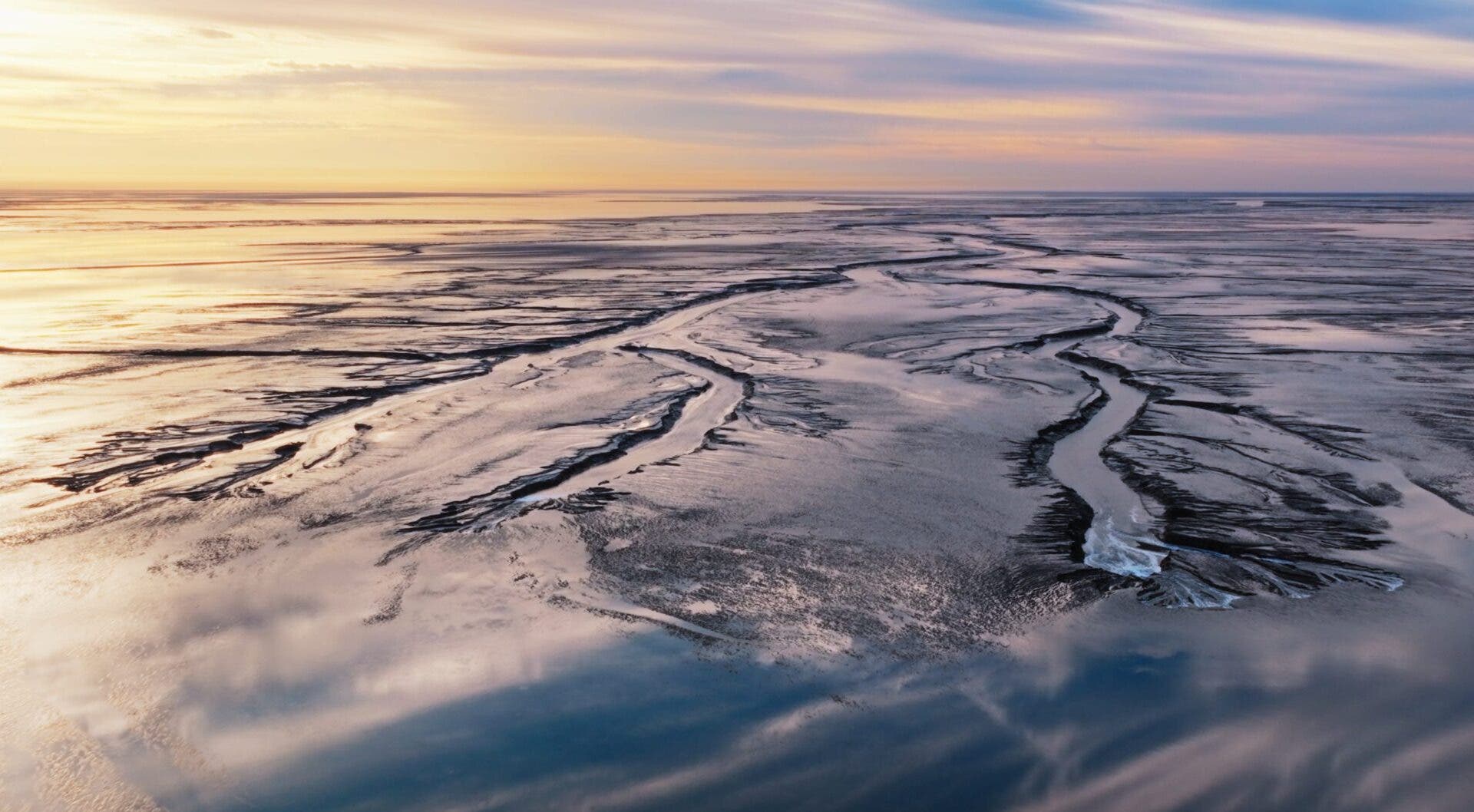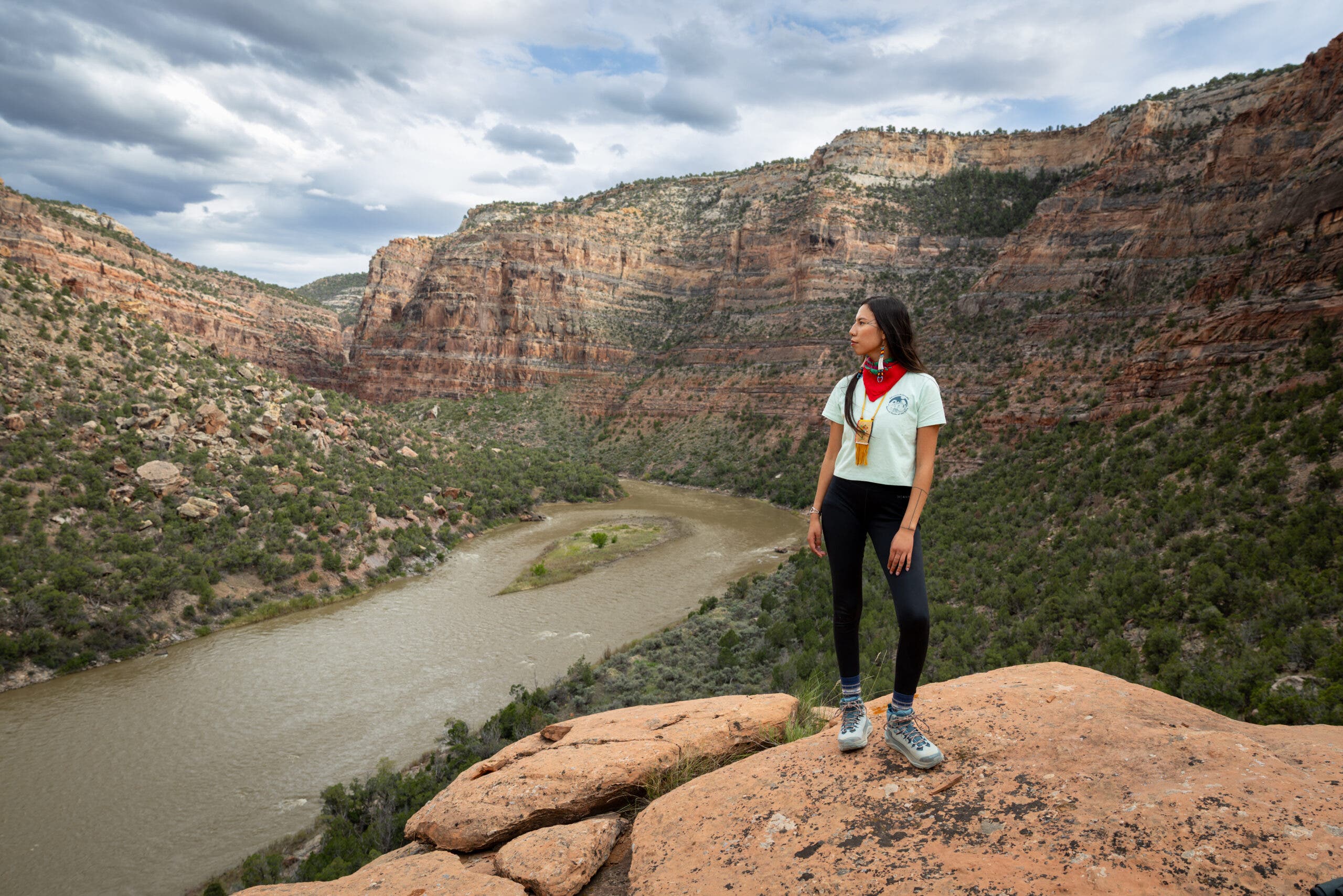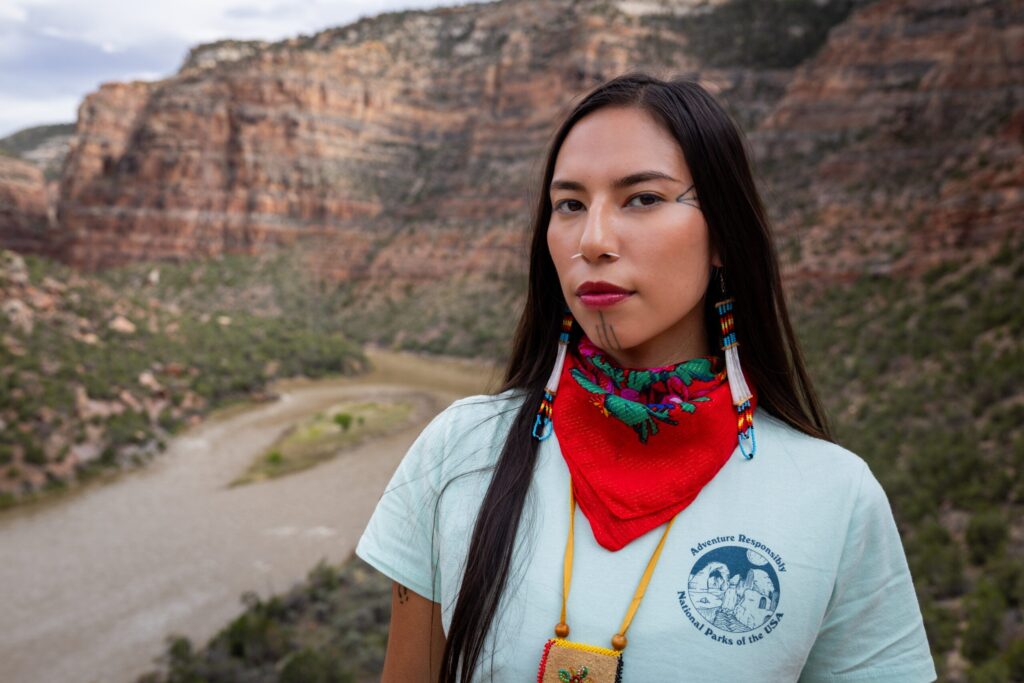Activist Quannah ChasingHorse is the climate hero we need right now. Here’s why she says Indigenous Peoples’ Day is more important than ever.
Quannah ChasingHorse (Photo: Len Necefer)
Published October 13, 2025 10:02AM
Indigenous model and activist Quannah ChasingHorse grew up in a tiny Native village in Alaska just south of the Arctic Circle, where she saw the effects of climate change firsthand her entire life. This experience and her deep connection with the land made her become an activist at a young age and use her platform as a model and actress to bolster Indigenous land rights and the climate.
In seventh grade, she fought to replace Columbus Day with Indigenous Peoples’ Day in her school district in Fairbanks. At 17, she became a member of the Gwich’in International Youth Council, lobbying against oil leases to protect native lands such as the Arctic National Wildlife Refuge, and participated in climate rallies. Before she was 18, she was helping the Alaska Federation of Natives Climate Task Force push to declare a state of emergency on climate change.
ChasingHorse’s powerful energy protesting against oil drilling caught the eye of a casting director for a Calvin Klein campaign in 2020. After she was scouted, her modeling career took off, and she used her visibility as a fashion model to bring more awareness to Indigenous communities and the climate crisis.
In 2023, ChasingHorse graced the fall Outside cover as a new face of adventure storytelling. She opened up to us about the “long walk from rural Alaska to the runways of Paris” and what it’s like living in two different worlds—fashion and activism, which was also chronicled in a documentary from The North Face called Walking Two Worlds.
This year ChasingHorse lent her voice to The American Southwest, a documentary by Ben Masters, which he describes as both a love letter and a plea to protect these landscapes and wildlife. The film is a wild ride down the mighty Colorado River, exploring the region’s extraordinary wildlife, cultural history, and precarious future, and ChasingHorse narrates.
Outside caught up with ChasingHorse while she was home in Fairbanks, Alaska. The activist tells us what drew her to The American Southwest, the most pressing issues for Indigenous communities right now, and what gives her hope in these uncertain times.

OUTSIDE: What drew you to narrating the 2025 film The American Southwest?
Quannah ChasingHorse: What drew me to narrate to The American Southwest was, knowing that there was not a lot of representation when it came to nature documentaries, whether that be film or TV shows, and also knowing the premise of it, understanding that the story is being told for a reason, and that it has to be told. It’s an important story, learning about water management and how that’s affecting so many life ways across, in, and out of the Colorado River.
I felt very called to lend my voice for all the different lifeways, whether that be the river to the animals to the landscapes of the American Southwest. There is a beautiful story there, and also to really share the history, and the importance of including that history, because Indigenous people have been stewarding these lands for generations, for thousands of years.
So to be an Indigenous person who has a connection to the Southwest, and to step into this role of being a voice for this region, it’s an honor, but also a responsibility.
What issues do you feel are most pressing for Indigenous communities today?
ChasingHorse: Every community has its own individual struggles, but overall, it is the lack of awareness anytime there’s anything happening in a Native community, you don’t hear about it on national TV. You don’t hear about it at all, unless someone close to you who is Indigenous knows what’s going on and informs you.
So the lack of awareness around these issues, whether that’s climate change, and how it’s affecting so many of our people, even here in Alaska and in the Southwest, we’re feeling heavy and hard. The water management in the Southwest is really playing into why the climate crisis is affecting the Southwest as far and as hard as it is.
When we talk about one thing, it’s hard not to talk about the other, because they are so interconnected. So all of these extractive industries, oil and gas and mining, and seeing the mismanagement of water and how all of that we as Indigenous people are the least to contribute to these issues, yet we are the most affected by it.
There are so many pressing issues, but right now specifically, I would say there is an ecocide and multiple active genocides happening, and we have been living in a dystopian reality. We have been overcoming this ongoing genocide for hundreds of years, and it is still happening today. So even just acknowledging that this is what’s happening, and we as Indigenous people need to be included in all spaces. That is what’s most pressing and most important, because then we can really help our communities when we’re included, and we can really bring forward solutions to a lot of today’s issues.
Why is it important to include Indigenous voices in conversation when it comes to the climate crisis?
ChasingHorse: In the last few years, we have also seen a lot of representation, but it is all very tokenized, so we need to really normalize Indigenous people in every space. We need to be included in these conversations, at the table when they’re making decisions on what is happening environmentally, to the economy, to water management.
All of the conversations surrounding this one pressing issue [of the climate crisis], we see so many people being put on pedestals whohad to find their way to that conversation. When us, as Indigenous people, we didn’t have a choice.
When it comes to climate change, we are at the forefront. We are affected the most. We are the ones who are on the forefront really being affected by these issues, by the climate crisis, yet our voices are not included in these conversations, and so every single panel, every single conference, every single conversation—whether that’s politically to communally—when our communities come together to talk about these issues, it is so important that there are Indigenous people who have the lived experience of what [the climate crisis] is like firsthand.
As an Indigenous person, I’ve seen way too many people who have so much privilege, but want to stay relevant, try to overstept, really take up space, and really try to step into this activist role. We do need more activists. We do need more people to care. We do need more people to speak up and say something, but they’re then overshadowing the Indigenous people who need to be heard, who have stories that need to be told.
It’s disheartening, because it makes us feel again, small, and makes us feel as though our stories are not important enough. Then he person who doesn’t quite know exactly what they’re talking about, and even if they do know what they’re talking about, they seem to be more important than the people who are directly being affected by these things.
How can we talk about these things without recognizing that, as much as this is a worldwide struggle, and everyone is feeling it, to some extent, a lot of those people can just go home and turn on their AC, or go home and turn on a hot shower and be in there for hours? A lot of us from our communities don’t have that luxury.

What’s your version of a perfect day outdoors?
ChasingHorse: A perfect day for me in the outdoors is getting bundled up, if it’s winter time, getting real bundled up, and spending time in my mom’s dog yard with her and her dogs, hooking up the dog team and heading out on a trail. Then, usually on our long runs, we’d stop and start a fire and have a little tea. And that’s one of my favorite things to do: building a fire and having some tea and sitting around and telling stories and spending time outside with my mom’s dogs.
When I’m not in Alaska, and I’m in the Southwest, in LA or in Arizona, then it’s going on hikes. There are so many beautiful trails all over the Southwest.
If you have access to hiking trails and beautiful spaces, and hot springs, go. It reconnects you with your spirit and your body. When I’m outside and doing these things and going on hikes and building fires and telling stories, I go back home feeling so much better.
I go home feeling like my cup is 100 percent full and overflowing like I can. I have so much more to give. I hope that when people do experience those things, that they then feel like they have enough to give, that they are overflowing with love and joy and happiness and clarity and groundedness, that they can just pour into other people and other things.
And the last question: How do you maintain hope as an activist?
ChasingHorse: Maintaining hope as an advocate these days can be challenging, if I’m being 100 percent honest. But then I go home to my communities, and I see young people really educating themselves, learning, engaging in these conversations.
That’s what gives me hope, seeing that our future leaders are going to be strong and knowledgeable, and will make decisions that will benefit everyone, not just themselves.
That is what gives me hope. And also knowing and seeing when all of us come together, seeing people protesting, seeing people speak up, and not being afraid to tell the truth, that gives me so much hope,
It reminds me that there is still humanity out there, that there are people who re still so grounded and connected to their humanness that they didn’t forget that or ignore that there are so many things that need voices, that need support, and need us as advocates to be there, to stand in solidarity with them.
These young people, especially children, shouldn’t have to do that. They shouldn’t have to grow up working their entire lives doing the right thing. It is our job. It is our parents’ and our grandparents’. It has been their job to create a future for us that is sustainable, that is livable and that is healthy. So I also hope to see more and more of our trusted adults and our aunties, our uncles, our moms, our dads, our grandparents, see a future for us and make the right choices on our behalf.
Editor’s note: This interview was edited for length and clarity.


